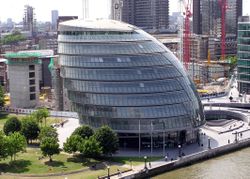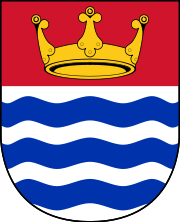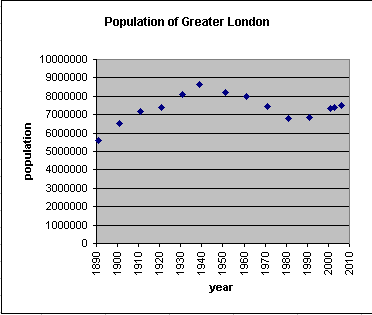Greater London
2008/9 Schools Wikipedia Selection. Related subjects: British Cities; Great Britain
 London region shown within England |
|
| Geography | |
|---|---|
| Status | Region † Administrative area Ceremonial county* |
| Area — Total |
Ranked 9th 1,579 km² 609 sq mi |
| NUTS 1 | UKI |
| Demographics | |
| Population — Total — Density |
Ranked 2nd 7,512,400(mid-2006) 4,758/km² (mid-2006) |
| GDP per capita | £27,633 ( 1st) |
| Government | |
| HQ | City Hall, Southwark |
| Assembly — Type |
London Assembly directly elected |
| Regional development | LDA |
| Authority | Greater London Authority |
| Mayor | Ken Livingstone |
| European parliament | London |
| Website | |
| Notes | |
| † - called London * - excluding the City of London |
|
Greater London is the top-level administrative subdivision covering London, England. The administrative area was created in 1965 and covers the City of London and 32 London boroughs. Its area also forms the London region of England and the London European Parliament constituency. The Greater London region has by far the highest GDP per capita in the United Kingdom.
It covers 1579 km² (609 square miles) and had a 2006 mid-year estimated population of 7,512,400. It is bounded by the Home Counties of Essex and Hertfordshire in the East of England region and Buckinghamshire, Berkshire, Surrey and Kent in South East England. The highest point in London is Westerham Heights, in the North Downs and on the boundary with Kent, at 245 metres (804 ft).
Status
Greater London is not a city in that it does not have official city status granted by the Crown. This is because one of the London boroughs, Westminster, is officially a city, as well as the City of London itself which would make such a status anomalous. Despite this, Greater London is commonly regarded as a city in the general sense of a municipality. A Lord Lieutenant of Greater London is appointed for its area, less the City of London; an area identical to the Metropolitan Police District; and for the purposes of the Lieutenancies Act 1997 this area is defined as a county.
The term "London" is normally used in reference to Greater London or to the overall conurbation, but not often to the ancient, tiny City of London in east central London. Instead, this small area is often referred to simply as "the City" or "the Square Mile" and it forms the main financial district. Archaically the urbanised area of London was known as the Metropolis. In common usage, the terms 'London' and 'Greater London' are usually used interchangeably to refer to the conurbation.
It is officially divided for some purposes, with varying definitions, into Inner London and Outer London. For strategic planning purposes the region is divided into five sub regions.
Politics
Regional government
London is the only English region with directly elected local governance. The Greater London Authority (GLA) comprises a regional assembly called the London Assembly and an executive head known as the Mayor of London. The current Mayor of London is Ken Livingstone who is not to be confused with the Lord Mayor of the City of London. He is scrutinised by an elected London Assembly, which may amend his annual budget (by two-thirds majority) but otherwise lacks the power to block his directives. The headquarters of the GLA is at City Hall in Southwark. The Mayor is responsible for Greater London's strategic planning and is required to produce a London Plan document.
Local government
Greater London is divided into 32 London boroughs, each governed by a London borough council; and the City of London, which has a unique government dating back to the 12th century. These various authorities are all often considered as equivalent to unitary authorities but not legally defined as such. All London borough councils belong to the London Councils association. Two London boroughs, Kensington and Chelsea, and Kingston, carry the purely honorific title of Royal borough. Withn the City of London boundary are two liberties, Middle Temple and Inner Temple.
Demographics
With increasing industrialisation, London's population grew rapidly throughout the 19th and early 20th centuries, and was the most populated city in the world until overtaken by New York in 1925. Its population peaked at 8,615,245 in 1939. There were an estimated 7,512,400 official residents in Greater London as of mid-2006. However, London's continuous urban area extends beyond the borders of Greater London and was home to an estimated 9,332,000 people in 2005, while its wider metropolitan area has a population of between 12 and 14 million depending on the definition of that area. According to Eurostat, London is the most populous city and metropolitan area of the European Union.
The region covers an area of 1,579 square kilometres. The population density is 4,761 people per square kilometre, more than ten times that of any other British region. In terms of population, London is the 25th largest city and the 17th largest metropolitan region in the world. It is also ranked 4th in the world in number of billionaires (United States Dollars) residing in the city. London ranks as one of the most expensive cities in the world, alongside Tokyo and Moscow.
Ethnic groups
In the 2001 census, 71.15% of these seven and a half million people classed their ethnic group as white, including White British (59.79%), White Irish (3.07%) or "Other White" (8.29%, mostly Greek Cypriot, Italian and French). 12.09% classed themselves as British Asian, including Indian, Pakistani, Bangladeshi and "Other Asian" (mostly Sri Lankan, Arab and other Southern Asian ethnicities). 10.91% classed themselves as Black British (around 7% as Black African, 4.79% as Black Caribbean, 0.84% as "Other Black"). 3.15% were of mixed race; 1.12% as Chinese; and 1.58% as other (mostly Filipino, Japanese, Korean, Vietnamese and other "British Orientals"). 21.8% of inhabitants were born outside the European Union. The Irish, from both the Republic of Ireland and Northern Ireland, number about 200,000, as do the Scots and Welsh combined.
In January 2005, a survey of London's ethnic and religious diversity claimed that there were more than 300 languages spoken and more than 50 non-indigenous communities which have a population of more than 10,000 in London. Figures from the Office for National Statistics show that, as of 2006, London's foreign-born population is 2,288,000 (31%), up from 1,630,000 in 1997. The 2001 census showed that 27.1% of Greater London's population were born outside the UK, and a slightly higher proportion were classed as non-white.
The table below shows the 'Country of Birth' of London residents in 2001, the date of the last UK Census. (Top 21). Note that a portion of the German-born population are likely to be British nationals born to parents serving in the British armed forces in Germany.
Country of Birth Population (2001)
- United Kingdom 5,230,155
- India 172,162
- Republic of Ireland 157,285
- Bangladesh 84,565
- Jamaica 80,319
- Nigeria 68,907
- Pakistan 66,658
- Kenya 66,311
- Sri Lanka 49,932
- Ghana 46,513
- Cyprus 45,888
- South Africa 45,506
- United States 44,622
- Australia 41,488
- Germany 39,818
- Turkey 39,128
- Italy 38,694
- France 38,130
- Somalia 33,831
- Uganda 32,082
- New Zealand 27,494
- Republic of Ireland 157,285
London has been a focus for immigration for centuries, whether as a place of safety or for economic reasons. Huguenots, eastern European Jews and Cypriots are examples of the former; Irish, Bangla Deshis and West Indians came for new lives. The East End district around Spitalfields has been first home for several ethnic groups, which have subsequently moved elsewhere in London as they gained prosperity.
Religion
The largest religious groupings in London are Christian (58.2%), No Religion (15.8%), Muslim (8.2%), Hindu (4.1%), Jewish (2.1%), and Sikh (1.5%). London has traditionally been Christian, and has a large number of churches, particularly in the City. The famous St Paul's Cathedral in the City and Southwark Cathedral south of the river are Anglican administrative centres, while the head of the Church of England and worldwide Anglican Communion, the Archbishop of Canterbury has his main residence at Lambeth Palace in the London Borough of Lambeth. Important national and royal ceremonies are shared between St Paul's and Westminster Abbey. The Abbey is not to be confused with nearby Westminster Cathedral, the largest Roman Catholic cathedral in England and Wales. Religious practice is lower than any other part of the UK or Western Europe and is around seven times lower than American averages. Despite the prevalence of Anglican churches, weekly observance is low within the Anglican denomination, although in recent years church attendance, particularly at evangelical Anglican churches in London, has started to increase.
London is also home to sizeable Muslim, Hindu, Sikh, and Jewish communities. Many Muslims live in Tower Hamlets and Newham; the most important Muslim buildings are the East London Mosque in Whitchapel and the London Central Mosque on the edge of Regent's Park. London's large Hindu community is found in the north-western boroughs of Harrow and Brent, the latter of which contains one of Europe's largest Hindu temples, Neasden Temple. Sikh communities are located in East and West London, which is also home to the largest Sikh Temples in the world, outside India. The majority of British Jews live in London, with significant Jewish communities in Stamford Hill (the most Orthodox Jewish area outside New York City and Israel) and St. John's Wood, Golders Green, and Edgware in North London.
See also List of churches and cathedrals of London
|
|
London Assembly
For elections to the London Assembly, London is divided into fourteen constituencies. The constituencies are formed from the area of two or three boroughs combined. The City of London forms part of the City and East constituency.
UK Parliament
London is divided into 74 Parliamentary constituencies, which are all small borough constituencies. They are formed from the combined area of several wards from one or more London Boroughs. Typically a single borough is covered by two or three constituencies. Their number will be reduced to 73 before the next general election.
History
Creation
Although the London County Council had been created as a London-wide authority covering the County of London in 1889, the County did not even cover all the built-up area of London then, particularly West Ham and East Ham; furthermore many of the LCC housing projects, including the vast Becontree Estate, were constructed outside its formal boundaries.
London County Council pressed for an alteration in its boundaries soon after the end of the First World War, noting that within the Metropolitan and City Police Districts there were 122 housing authorities. A Royal Commission on London Government was set up to consider the issue. London County Council proposed a vast new Greater London, somewhere between the Metropolitan Police District and the entire Home Counties. Protests were made at the possibility of including Windsor, Slough and Eton in the authority.
The Commission made its report in 1923, rejecting the LCC's scheme. Two minority reports favoured change beyond the amalgamation of smaller urban districts, including both smaller borough councils and a Central Authority for strategic functions. The London Traffic Act 1924 was a result of the Commission.
Greater London was formally created by the London Government Act 1963, which took force on 1 April 1965, replacing the former administrative counties of Middlesex and London, adding the City of London, which was not under the London County Council, and absorbing parts of Kent, Surrey, Essex and Hertfordshire. The term 'Greater London' had been used well before 1965, particularly to refer to the area covered by the Metropolitan Police District (such as in the 1901 census), the area of the Metropolitan Water Board (favoured by the London County Council for statistics), the London Passenger Transport Area and the area defined by the Registrar General as the Greater London Conurbation.
Greater London Council
Greater London originally had a two-tier system of local government, with the Greater London Council (GLC) sharing power with the City of London Corporation (governing the small City of London) and the 32 London borough councils. The Greater London Council was abolished in 1986 by the Local Government Act 1985. Its functions were devolved to the Corporation and the London boroughs with some functions transferred to central government and joint boards.
Greater London Authority
Greater London was used to form the London region of England in 1994. A referendum held in 1998, established public will to create a regional authority. The Greater London Authority, London Assembly and the directly elected Mayor of London were created in 2000 by the Greater London Authority Act 1999. The 2000 and 2004 mayoral elections were both won by Ken Livingstone, who had been the final leader of the GLC. In 2000 the outer boundary of the Metropolitan Police District was re-aligned to the Greater London boundary.
Statistics
Population
The population on the current territory of Greater London rose from about 1.1 million in 1801 (back then only about 0.85 million people were in the urban area of London, while 0.25 million were living in villages and towns not yet part of London) to an estimated 8.6 million in 1939, but declined to 6.7 million in 1988, before starting to rebound in the end of the 1980s. As of 2006, the population in Greater London has only recovered the level of 1970 (which was also the level of population in the 1920s). Some researchers expect the population of Greater London to reach 8.15 million by 2016, which would still be 0.45 million short of the 1939 peak.
Figures here are for Greater London in its 2001 limits. Figures before 1971 have been reconstructed by the Office for National Statistics based on past censuses in order to fit the 2001 limits. Figures from 1981 onward are midyear estimates (revised as of August 2007), which are more accurate than the censuses themselves, known to underestimate the population of London.
| 1891 | April 5/6 | 5,572,012 |
| 1901 | March 31/April 1 | 6,506,954 |
| 1911 | April 2/3 | 7,160,525 |
| 1921 | June 19/20 | 7,386,848 |
| 1931 | April 26/27 | 8,110,480 |
| 1939 | Midyear estimate | 8,615,245 |
| 1951 | April 8/9 | 8,196,978 |
| 1961 | April 23/24 | 7,992,616 |
| 1965 | Greater London formally created | |
| 1971 | April 25/26 | 7,452,520 |
| 1981 | Midyear estimate | 6,805,000 |
| 1988 | Midyear estimate | 6,729,300 |
| 1991 | Midyear estimate | 6,829,300 |
| 2001 | Midyear estimate | 7,322,400 |
| 2002 | Midyear estimate | 7,361,600 |
| 2003 | Midyear estimate | 7,364,100 |
| 2004 | Midyear estimate | 7,389,100 |
| 2005 | Midyear estimate | 7,456,100 |
| 2006 | Midyear estimate | 7,512,400 |
Economy
This is a chart of trend of regional gross value added of Inner London at current basic prices published (pp.240-253) by Office for National Statistics with figures in millions of British Pounds Sterling.
| Year | Regional Gross Value Added | Agriculture | Industry | Services |
|---|---|---|---|---|
| 1995 | 64,616 | 7 | 8,147 | 56,461 |
| 2000 | 92,330 | 6 | 10,094 | 82,229 |
| 2003 | 112,090 | 12 | 10,154 | 101,924 |
This is a chart of trend of regional gross value added of Outer London at current basic prices published (pp.240-253) by Office for National Statistics with figures in millions of British Pounds Sterling.
| Year | Regional Gross Value Added | Agriculture | Industry | Services |
|---|---|---|---|---|
| 1995 | 44,160 | 51 | 10,801 | 33,307 |
| 2000 | 60,304 | 43 | 12,529 | 47,732 |
| 2003 | 67,582 | 39 | 13,081 | 54,462 |
Area
The area of Greater London has not changed significantly since its creation. There have been a considerable number of small boundary changes. The most significant of these were the 1969 transfers of Knockholt to Kent and Farleigh to Surrey and a series of minor adjustments during the 1990s which realigned the boundary to the M25 motorway in some places.
Environment
The majority of Greater London forms the London low emission zone from 4 February 2008.
Education
The education system has been split into the thirty three separate LEAs, which correspond to the City of London and the 32 London boroughs, since the 1990 enactment of the Education Reform Act 1988. From 1965 to 1990, twelve Inner London boroughs and the City of London had been served by an Inner London Education Authority. The introduction of comprehensive schools, directed by Circular 10/65 in 1965, was mostly followed in Greater London, however 19 grammar schools have been retained in some Outer London boroughs. At GCSE and A level, Outer London boroughs have broadly better results than Inner London boroughs.
Wider population
Greater London is not exactly coterminous with London's built up area and a somewhat wider Greater London Urban Area has been defined and is used for mainly statistical purposes. London's wider metropolitan area is known as the London commuter belt and is delimited by a variety of definitions.




